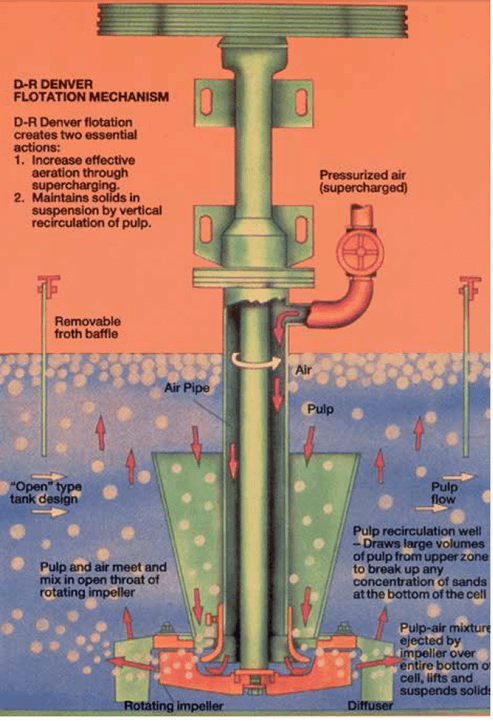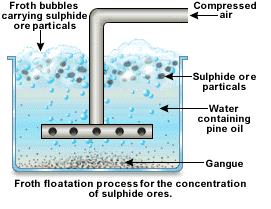 Froth Flotation is a mineral processing process achieving solid-solid separation by taking profit of the chemical attribute leading to the possibility of selectively controlling the relative surface hydrophobicities of the various components mixed in an aqueous medium.
Froth Flotation is a mineral processing process achieving solid-solid separation by taking profit of the chemical attribute leading to the possibility of selectively controlling the relative surface hydrophobicities of the various components mixed in an aqueous medium.
Froth flotation is the most common industrial process based on this approach. The term surface hydrophobicity refers to the tendency of the particle surface to neither want to closely associate with water nor to form hydrates of water on its surface. Particles that repel water from their surfaces (i.e. those with surfaces that are water hating or hydrophobic) have a tendency to prefer associating with oily or hydrocarbon based materials on their surfaces.

All of us know from our daily life experience that oil and water do not mix well and will have a tendency to separate into physically distinct phases unless continuously agitated. In a somewhat analogous manner, fine particles that naturally are hydrophobic or that are made hydrophobic through the use of appropriate chemicals adsorbed on their surfaces are inherently unstable in a water environment. On the other hand, the hydrophilic (water-loving) surfaces are compatible with water as evidenced by the difficulty of removing water even by drying with heat. Thermodynamically, the hydrophobic.
The process of froth flotation is based on the simple idea of using air bubbles to provide an escape mechanism for these particles that are hydrophobic on their surface from the water-based mixture of particles. Because of the free energy driving forces associated with hydrophobic surfaces in water coupled with the associated inter-facial surface tensions involved with particles, water, and gas bubbles, the hydrophobic particles prefer to attach to the gas (usually air) bubbles rather than stay in the water. Once such particles are attached to the gas bubbles, the bubbles can then carry the hydrophobic particles to the surface of the constantly agitated water-solids mixture (referred to as the pulp). At the surface, a stabilized froth is formed which can then be removed (skimmed) from the mixing vessel, and the material is said to be recovered.
Learn How to evaluate a flotation circuit.
The unattached hydrophilic material (referred to as gangue) remains submerged in the pulp and is either discarded or reprocessed. The definition of what is valuable or not in any given froth flotation process is strictly dependent on the nature of the fine particle components present in the over-all mixture of particles. Sometimes, the more hydrophobic material collected in the valuable or concentrate froth phase is of greater economic value than is the gangue. In other cases, the more hydrophobic particles are simply the undesired impurities in the mixture with the gangue being the more economically valuable (purified) component.
